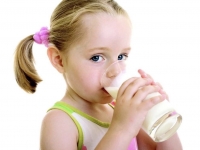Allergy to breast milk in children: symptoms and risk factors
 Milk is a useful product that contains calcium, various vitamins and minerals, rich in proteins and fats. However, milk is not always useful for children, and in some babies (about 10% of the total) milk allergy is present. How to understand that this problem is just about your child?
Milk is a useful product that contains calcium, various vitamins and minerals, rich in proteins and fats. However, milk is not always useful for children, and in some babies (about 10% of the total) milk allergy is present. How to understand that this problem is just about your child?
Why is there an allergy to milk protein?
The protein that is part of the cow’s milk, falling into the body, breaks down into separate elements, which are usually well digested. However, in children, the digestive system is immature, and they may not have the necessary enzymes to split the protein. Because of this, the immune response of the body arises in the form of symptoms of allergy. It is not necessary to confuse the concept of allergy and intolerance of milk. In the first case, the child’s immune system reacts to an alien protein, and in the other – there are difficulties with digestion of milk, the immune system is here to nothing.
It should be understood that for a child of the first year of life contraindicated cow or goat milk, it is suitable only for mother’s milk or an adapted milk formula.
The exact causes of the development of allergy to the milk protein in a child are unknown, but there are factors that may affect the inadequate immune response of the body. They include:
heredity;
negative impact of bad ecological situation;
malnutrition, lifestyle;
the health and age of the baby’s mother during pregnancy;
the nature of the pregnancy;
stressful situations;
Infectious diseases.
Symptoms of allergy to milk protein
The most obvious signs of allergy to milk protein include the following:
Dairy scab – a specific skin on the head of a child.
Eczema, which most often appears on the cheeks, but may also be on other parts of the body. First there are bubbles, then erosions, in which the transparent liquid accumulates, then the wounds heal, and in their place there is peeling and crust.
Quincke’s edema is an acute allergic reaction to dairy product ingestion. It is a swelling of the mucous membrane of the mouth, lips, eyelids, genital organs, throat, which can be very dangerous because of the risk that the baby will suffocate if she does not provide the necessary help in time.
Trotter – blisters with reddening around, which are very scaly.
Respiratory tract infection: sneezing, allergic rhinitis, difficulty in breathing, wheezing.
Bronchial asthma. Allergy to cow’s milk protein is one of the mechanisms that triggers the development of this disease.
Problems with digestion, bloating, diarrhea.
It should be known that sour-milk products do not usually cause allergic reactions in children. This is because when milk is processed during the manufacture of sour milk products, the milk protein breaks down into amino acids, simple compounds that are rapidly and easily digested by the body, including children.
When the baby grows up and finally develops immune and enzymatic systems, the allergy to the milk protein usually takes place. As long as there are symptoms of milk allergy, this product should be completely excluded from the baby’s diet.
Sour milk products can completely replace the lack of milk in the baby’s diet. Therefore, there is no tragedy in the presence of allergy to milk protein, the more so that children usually it just grows up. Often, the immune response of the child’s body to the allergen becomes much less pronounced after 3-5 years of age.



